13 Best Duplicate File Finders for Mac & Windows in 2022
With so many different methods for file sharing and storage these days, it’s not hard to waste hard disk storage on duplicate files. Sooner or later, your computer is loaded with duplicate files which take a large amount of precious disk space, until one day you see those annoying “disk almost full” warning pop-ups.
To tam gdzie duplicate file finder software comes to play. These apps can help detect duplicates and similar files quickly so you don’t have to spend hours, if not days, sorting them out. By removing those redundant files, you can free up tons of storage space on your computer’s hard drive.
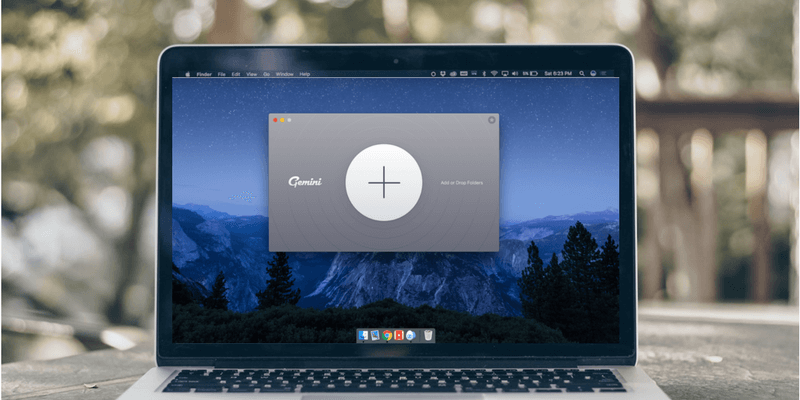
After carefully testing and reviewing nearly twenty duplicate file finder and remover apps, we believe Gemini 2 is the best for Użytkownicy komputerów Mac. Besides finding exact duplicates, this powerful app can also detect similar files, which is perfect for deleting unnecessary copies of photos, videos, and backups you sync between your iPhone/iPad and Mac machine.
For those who use a Windows PC, we believe you should check out Duplikat Cleaner Pro, a program specifically designed to free up your PC hard drive by searching and deleting duplicate items. It can deep scan for all types of files (photos, videos, music, documents, and more), and provides tons of customized file matching options. Best of all, the DigitalVolcano team provides supporting materials and tutorials that are very helpful.
Oczywiście jest Easy Duplicate Finder — which is also a great choice. We think it’s probably the best utility that adds the most value for those who use both a PC and a Mac. The app scans for duplicate files fast and accurately, and it offers two flexible views for selecting duplicates to delete. It’s compatible with both Windows and macOS.
We also reviewed and covered a number of other duplicate finders including free software options for Windows and macOS. You might find some of them useful as well. Read our research below to learn more.
Spis treści
Why Trust Us for This Software Guide
Hi, my name is Kristen. I took a bunch of computer science classes in college as part of my minor and decided back then I wasn’t into coding/programming — but I love computers. I’m just a regular user now who appreciates simple, straightforward user interfaces and programs I don’t have to fight with to make them work. I have an ASUS computer, an iPhone, and a few other gadgets to do my research on. I tested twelve different duplicate file finders on my Windows 8-based laptop for this article.
I use my PC for very basic functions, it’s been a while since I’ve gone through my document and photo files and organized them. You might use a service like DropBox, iCloud, or Google Drive to backup the same documents or photos that you’ve already transferred multiple times onto your laptop. That’s when you’ll probably need a duplicate file finder app that allows you to quickly search for large, old, duplicate files and give you the option to view and delete them.
Since I’m mostly on a PC, and given that some duplicate finder programs also support macOS, my teammate JP tested a number of Mac duplicate finders on his MacBook Pro. He’ll share detailed findings of those Mac apps.
Our goal is to test a group of well-known programs and share the absolute best so you save time exploring programs that may or may not add value to your computing life. We hope this review will give you some insights, and that you walk away choosing a great duplicate finder that will help free up space on your PC or Mac.
Disclaimer: The opinions in this guide are all our own. No software developers or merchants mentioned in this post have any influence on our testing process, nor do they get any editorial input on the content. In fact, none of them know we are putting together this review before we post it on TechFewer.
Getting to Know Duplicate File Finders
What causes duplicate files? The most obvious answer is computer users save too many versions of the same file in multiple places. If you’re like me, you may keep the same photo albums or videos stored on your phone, digital camera, social media, and your computer. You’re reluctant to go back and organize them… until one day your computer hard drive is out of space.
Another common source of duplicates is similar files. For example, when you take a selfie, most likely you’ll take several photos, pick the perfect one, and post it on Facebook or Instagram. What about the other un-picked ones (as we call, similar photos)? They often get ignored. That’s okay most of the time. But when you sync these images between your phone and computer, the lack-of-storage problem will occur sooner or later. You’ll then realize how much storage is taken up by those unneeded similar pictures.
Chances are, this is when you’ll start searching for ways to find those duplicates and similar files — then duplicate file finder software comes to your attention, right? Those software developers are intelligent! They know our pain. They take the time to design and develop these kinds of applications to help us root out unnecessary files quickly. But be aware that duplicate finder apps aren’t magical one-click-and-you’re-done time-savers.
Don’t be fooled by the over-promises made by those “unethical” providers — especially those who claim they can save you 20GB of disk space in just two minutes. That’s often impossible because searching or scanning for duplicates takes time, and reviewing them is often a time-consuming process. Therefore, it is always recommended that you carefully review each item before deciding to delete it just in case of misoperation.
Also, it is worth noting that duplicate items aren’t necessarily meant to be removed. You may have good reason to keep them in different folders, especially when your computer is shared with someone else. You create different folders to separate content and it’s totally possible that some files overlap between you and other users. You don’t want to delete those overlapped items without permission!
Who Should Get (or Avoid) This
First off, you don’t need duplicate finder software at all if your computer has enough storage, or you rarely save multiple copies of a file (be it a photo, video, or phone backup). Even if you do, sometimes you can just take several minutes to go through these frequently-used folders and sort them out — unless there are thousands of them and it’s impossible to take the time to manually check each folder.
The main value of these programs is saving time. Why? Because, as we already mentioned, manually searching for extra files you’ve saved on a hard drive is often tedious and incomplete. For instance, it’s totally possible that you might have backed up the same photo album seven times while the original one is hidden somewhere deep in a disk that requires seven clicks to access.
In a nutshell, here are some scenarios where you might use duplicate finder software:
- Your computer is running out of disk space.
- Your hard drive is stuffed with many exact duplicates of files and folders.
- You regularly sync media files between your phone/tablet and your computer.
- You back up your iOS devices with iTunes now and then.
- You often transfer pictures from your digital camera to a computer.
You may NOT need a duplicate finder when:
- Your computer is relatively new and has plenty of storage to use.
- Your hard drive is almost full but you’re certain that it’s not caused by duplicate files.
- You have a reason to keep those duplicate items.
In addition, keep in mind that when your PC or Mac lacks storage you can often reclaim much disk space by using a cleaning program. We’ve reviewed the najlepszy środek do czyszczenia komputera i best Mac cleaning software previously. For example, if you have installed too many third-party programs, the cause for low disk space is that the hard drive (or solid-state drive) has been occupied by program files, and you should try to uninstall those unneeded programs to reclaim space.
Best Duplicate File Finder: The Winners
First things first: before you use any duplicate file finder software, it’s always good practice to back up your PC i mak beforehand, just in case. As they say — backup is king in the digital age!
Best Duplicate Finder for Mac: Gemini 2
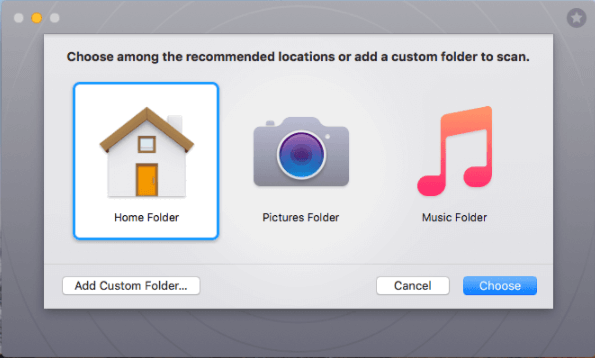
Gemini 2 helps you find duplicate and similar files on your Mac. By wiping these duplicates, you can recover tons of space. Of course, this only happens when your Mac is filled with copies such as redundant backups, similar photos, etc. What we especially like about Gemini 2 is its sleek user interface, well-designed navigation flow, and best of all its duplicate detection capability.
The main screen of the app is shown as above. Once you install and open it on your Mac, you choose a mode to get started. For example, to find duplicate images, select “Pictures Folder.” For songs, you select “Music Folder.” You can also add a custom folder for a scan. Next, wait for the scan to complete. Depending on the number of files in that folder, it may take seconds or minutes for the process to complete.
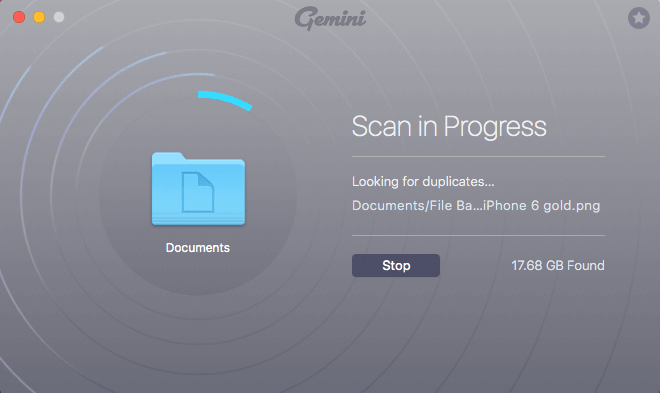
Pro napiwek: during the scan, it’s best that you quit other working apps to avoid Mac overheating issues. We found Gemini 2 was a bit resource-demanding, and JP’s MacBook Pro fan ran out loud. Learn more from this detailed Recenzja Gemini 2 we wrote earlier.
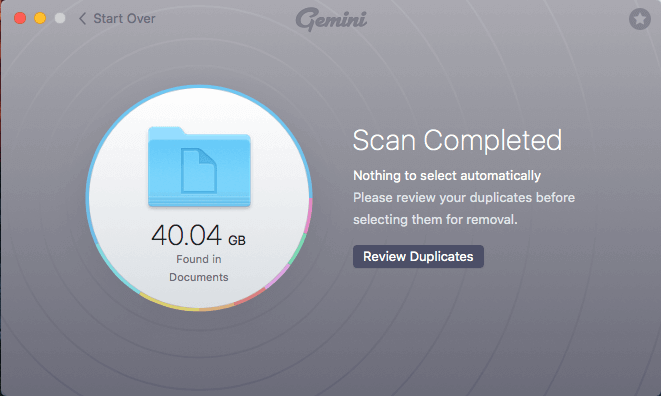
Then, review duplicates once the scan is completed. This step requires extra attention and can be quite time-consuming as well. Thankfully, Gemini 2 makes it easy for us to sort through the duplicates list (grouped by Exact Duplicates and Similar Files, as shown below). It also automatically selects the duplicate or similar items the app thinks are safe for removal.
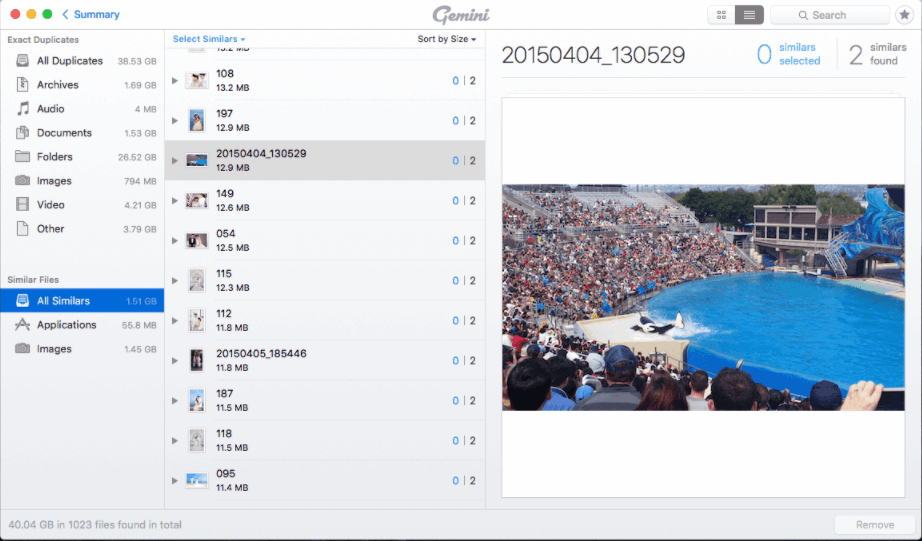
But the machine is the machine: Files the app thinks are safe to delete aren’t always files you should be getting rid of. So, try to review each group of files and make sure to only select those items you think are okay to get rid of. Incidentally, Gemini 2 moves them to Trash; you still have the chance to restore them in case some items get deleted that shouldn’t have.
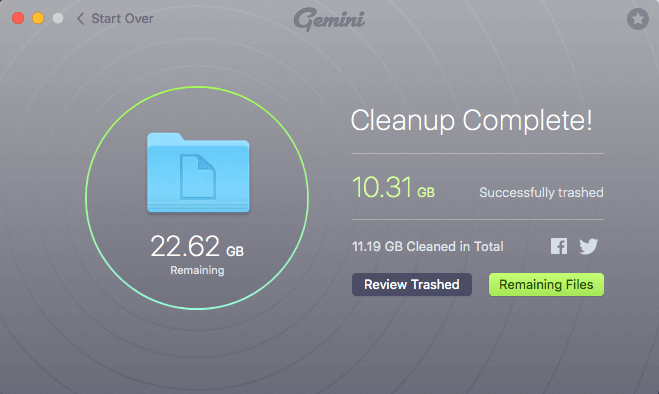
In JP’s case, he spent about 10 minutes reviewing these duplicates and ended up freeing 10.31GB in storage, which he can use to store several thousand new photos. Not bad!
Gemini 2 offers a trial version that allows you to remove 500 MB files maximum. If you exceed the limit, you need to pay to activate the full version. The price for that is $19.95 per single license.
Best Duplicate Finder for Windows: Duplicate Cleaner Pro
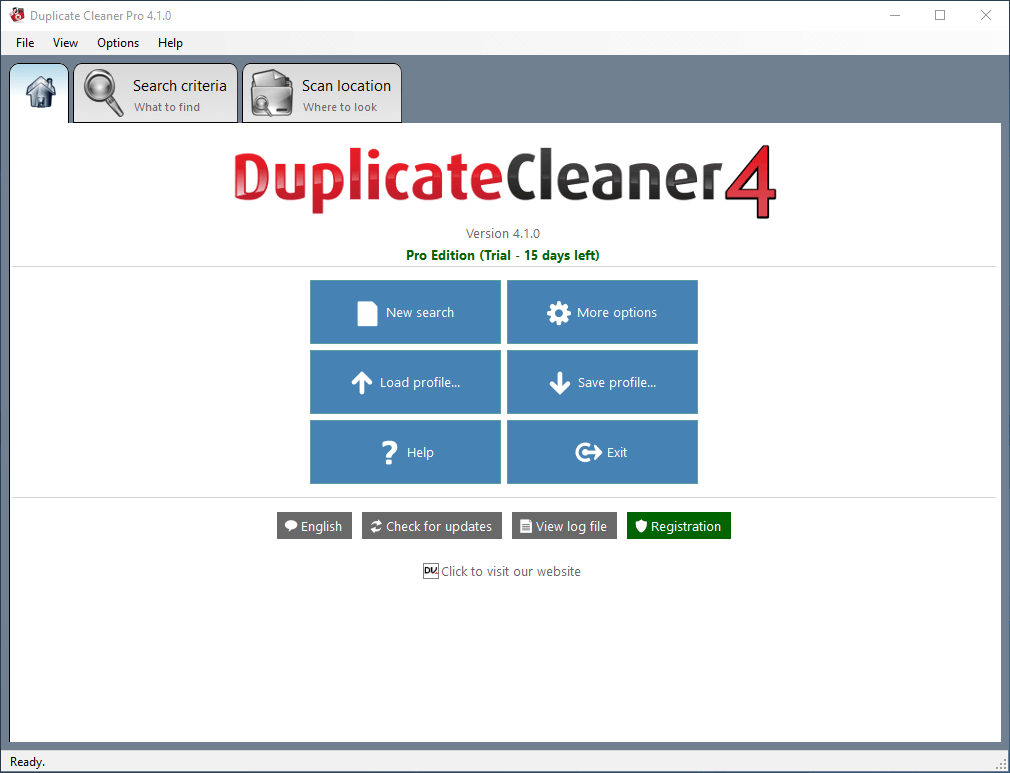
DuplicateCleaner 4, as its name says, is a pure duplicate cleaner program developed by DigitalVolcano, a UK-based software company. Before we tested the program, the tutorials their support team curated (in both video and text format) impressed us quite a bit.
In our opinion, Windows applications usually lack in user experience compared to Mac apps. After trying a number of PC duplicate finder programs, we’ve yet to find one that can match the level of Gemini 2 in terms of ease of use. But DuplicateCleaner certainly wins both in capability and usability for the PC user.
To get started, all you need to do is click “New Search”, define the criteria (e.g. file matching types by same or similar content), select the folders or locations you’d like the program to search and hit the “Start Scan” button.
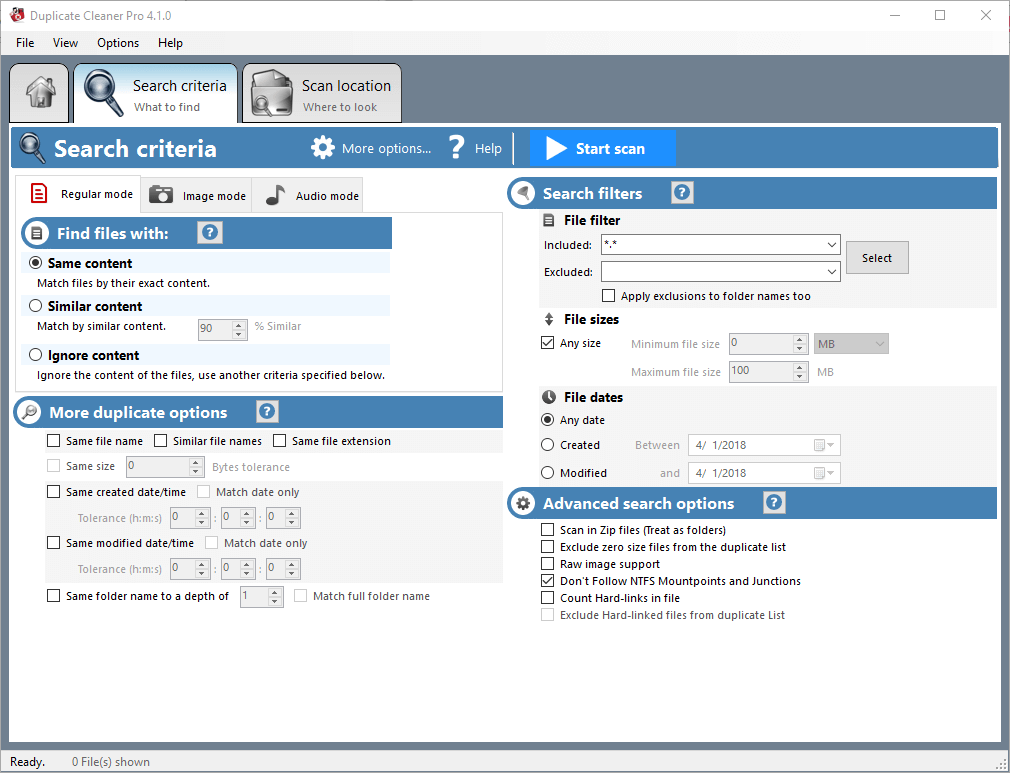
Once the scan is complete, an overview window is presented so you can understand how much disk space those duplicates have taken. Then comes the review process: You check each group of items and delete the unneeded ones. DuplicateCleaner Pro will then move them to the Recycle Bin.
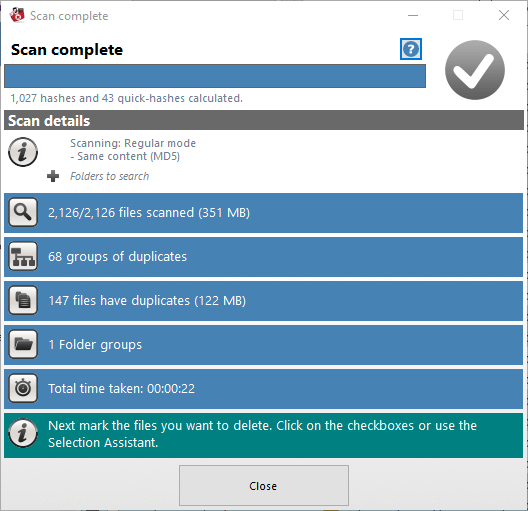
If you have questions about using the program, ten samouczek wideo made by DigitalVolcano earlier this year should be very helpful. You may also click on the question mark inside the program which will bring you to the manual. The step-by-step instructions are very helpful as well.
We tested the latest version, 4.1.0. The program is compatible with Windows 10, 8, 7 and Vista. The trial version is free for 15 days, with certain function limitations: Import/Export is disabled, and file removal limited to groups 1-100. A single-user license normally costs $29.95; right now it’s on sale for a bit less.
Also Great: Easy Duplicate Finder (macOS & Windows)
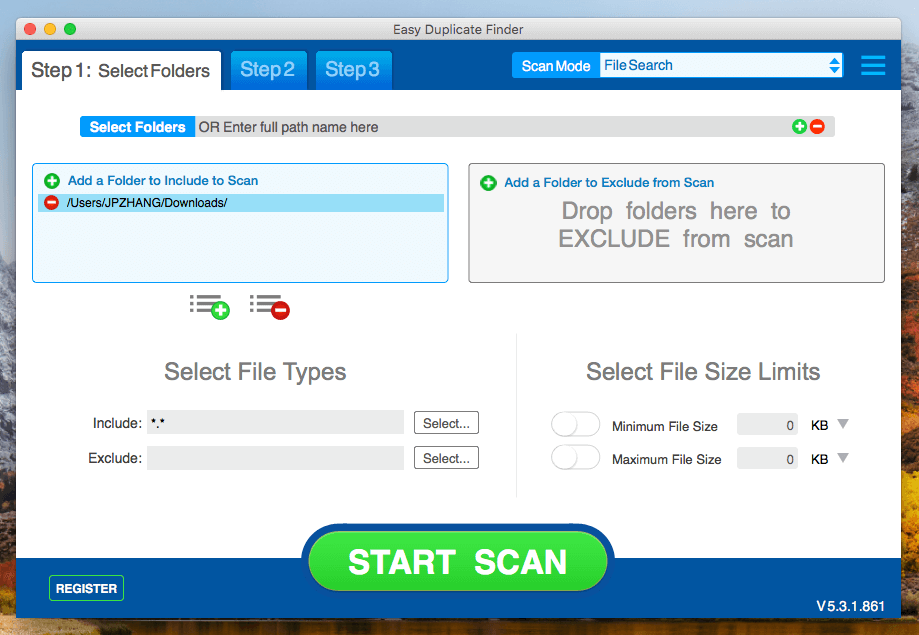
Easy Duplicate Finder is also a powerful program that you can select from the multiple scan modes and let the program only to search specific file types. In addition, you can use the app to scan online storage like Google Drive and Dropbox. Although the user interface of this program isn’t as sleek as that of MacPaw Gemini, the step-by-step instructions make it extremely clear where you should start. For example:
- Step 1: Select folders for a scan;
- Step 2: Wait until the scan is complete;
- Step 3: Review found duplicates and delete them.
One thing we’d like to point out (because it confused us initially) in particular is the “Scan Mode”, which is located on the upper-right corner of the app. Personally, we think this is a key feature that somehow got hidden away.
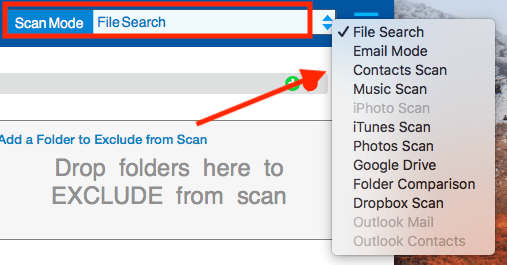
One weird thing that JP found: while launching the app, it directed him to sync a Google account, and it turned out that the Scan Mode he selected was “Google Drive”. He had no idea why that was the case. Perhaps it’s because he used Easy Duplicate Finder before and the app remembered his last scan. Anyway, the point is, the very first step you should take is selecting a scan mode, and then going to Step 1 as instructed.
To save time, Easy Duplicate Finder allows you to select specific file types to scan. This helps shorten the scan process and makes it easier for you to review found items later on.
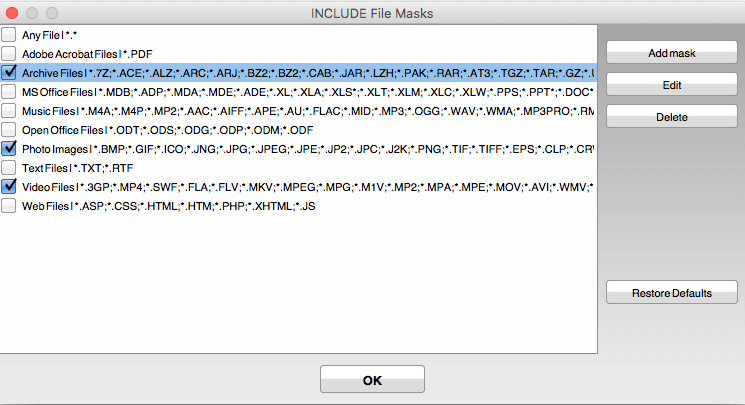
Once my scan was finished, the app showed an overview of the results: 326 duplicates found from the Download folder, with a potential 282.80 MB space that could be saved. All you need to do is click the green “Step 3: GO FIX THEM!”
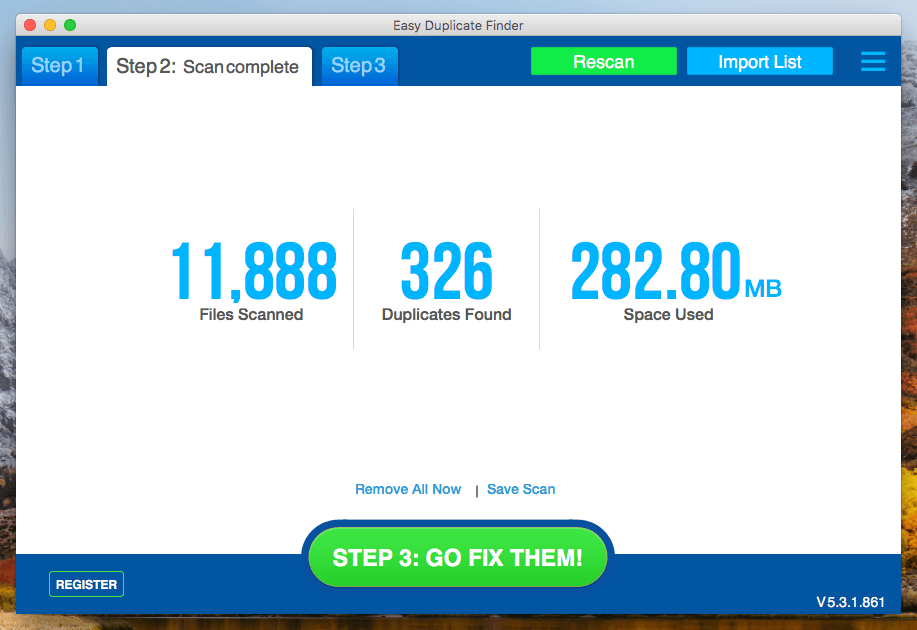
You’ll see more details about which files are perhaps redundant. By default, Easy Duplicate Finder automatically selects the duplicates, supposing that all you want is to trash them. But it’s always a good practice to review each item as carefully as you can, just in case of any misoperations.
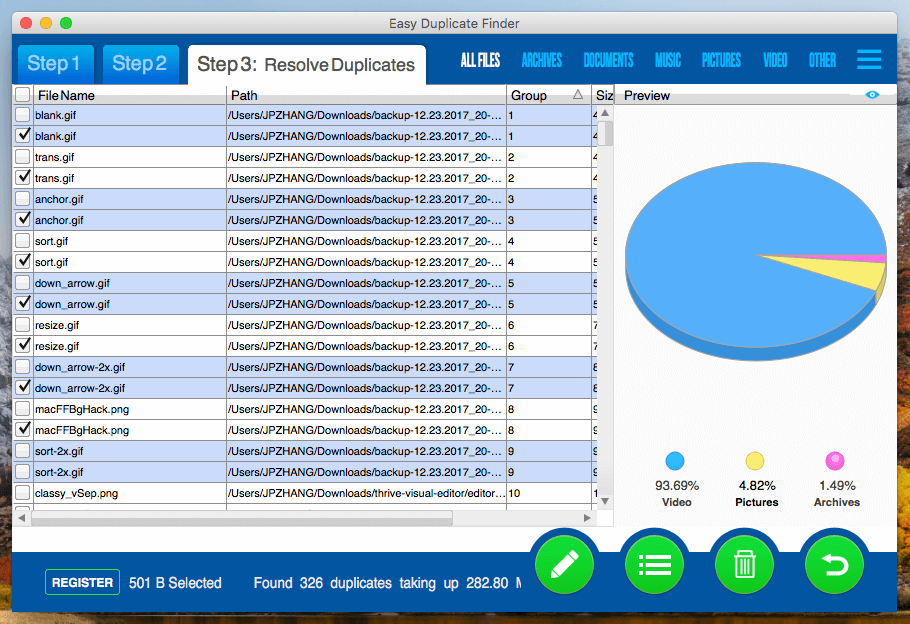
The trial version has a limit of removing only 10 duplicate file groups. To bust this limit, you need to upgrade to the full version which requires payment. Licenses start from $39.95 for one computer. The app supports both PC (Windows 10/8/Vista/7/XP, 32 bit or 64 bit) and Mac machines (macOS 10.6 or above). For more test findings, read this full review our teammate Adrian wrote a while back.
Other Good Paid Duplicate File Finders
Please note that these programs covered below are NOT freeware. They often provide free trials which limit how many scans you can run or whether you can delete your duplicate files before the trial version is up. Eventually, you’ll need to purchase a license to remove those limitations. That said, putting them in this section doesn’t make them any less capable than the three winners we chose. We value simplicity and uniformity.
1. Wise Duplicate Finder (for Windows)
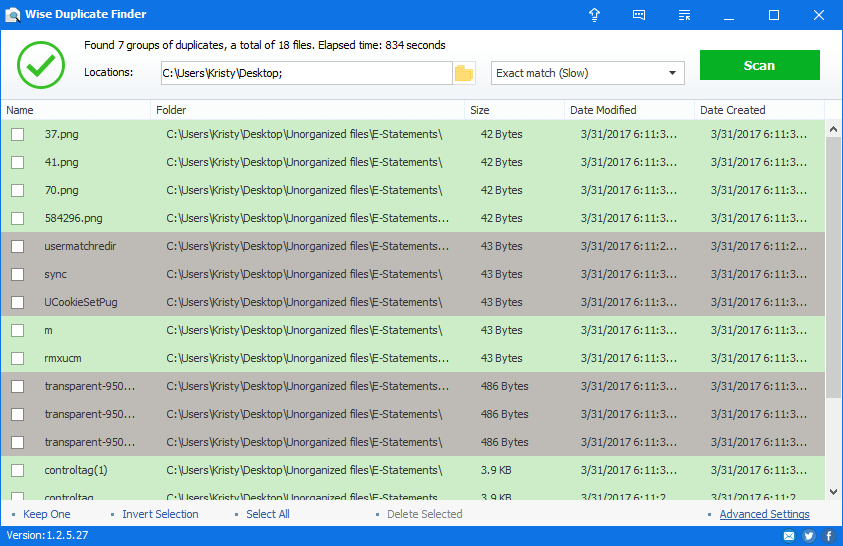
Projektanci Mądra wyszukiwarka duplikatów made it super easy for users by providing pre-loaded scans: matching file name/size (quick), partial match (slower), exact (slowest), or 0 bytes (empty files). The quickest scan of my desktop for duplicates was lightning fast but only produced 5 results. I tested the other two out of curiosity. Partial match showed me 8 duplicates and exact match (which did a far more thorough, but annoyingly plodding scan — 14 minutes long) resulted in 7 duplicates.
The program lets you select files manually, or for your convenience, you can set it to “Keep One” and be done with the cleaning in one mass delete. The advanced search settings window brings up a bunch of file extensions to include or exclude and a range of minimized/maximized bytes. You can also search by keyword if you know specifically what you’re looking for. You can Invert Select/Unselect every file on the results list, or delete them. The Pro version of Wise Duplicate Finder costs $19.95 a year, plus a $2.45 registration backup fee, and unlocks the Keep One feature (which I wasn’t able to test).
2. Tidy Up 5 (for Mac)
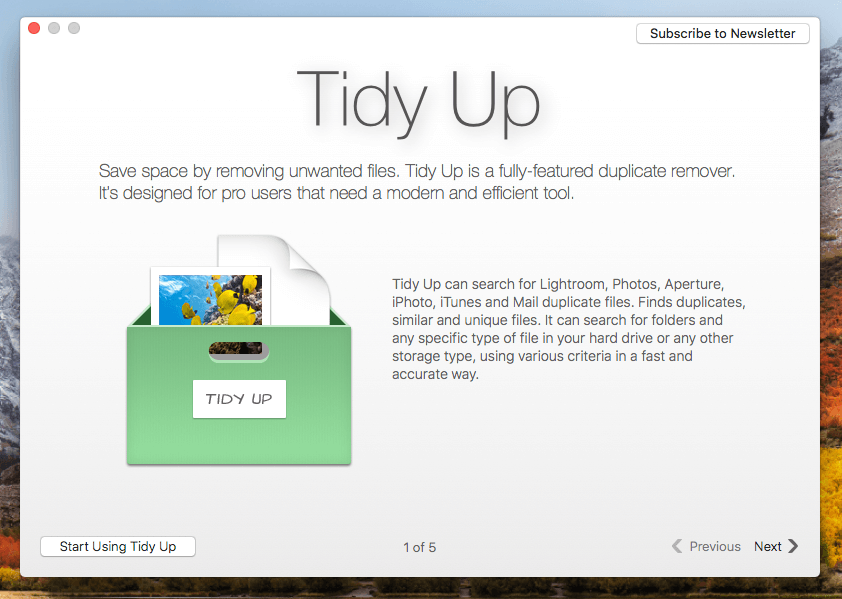
Boasting itself as “the new generation of duplicate finders and disk tidiness”, Sprzątać claims it’s the only fully-featured duplicate remover available on the market. After playing around with the app, I agree with the vendor’s claim. It’s indeed a sophisticated duplicate finder app with a plethora of features — which sometimes can be confusing. That’s why Hyperbolic Software positions the product as “A must-have for pro users”.
Installing Tidy Up on my MacBook Pro is quick and straightforward. If it’s your first time running the app, it’ll show you this 5-page introduction which is very helpful. However, one thing that puzzles me is that a helper tool popping up asking me whether I want to install it. I chose “Don’t Install Now” because I could not get what it does.
Once you click “Start Using Tidy Up”, you’ll see a screen similar to this. Note that on the top, I slid from “Simple mode” to “Advanced mode”. That’s why I was given so many checkboxes to select before running a scan — more precisely, a Search, as shown in the bottom corner of the app.
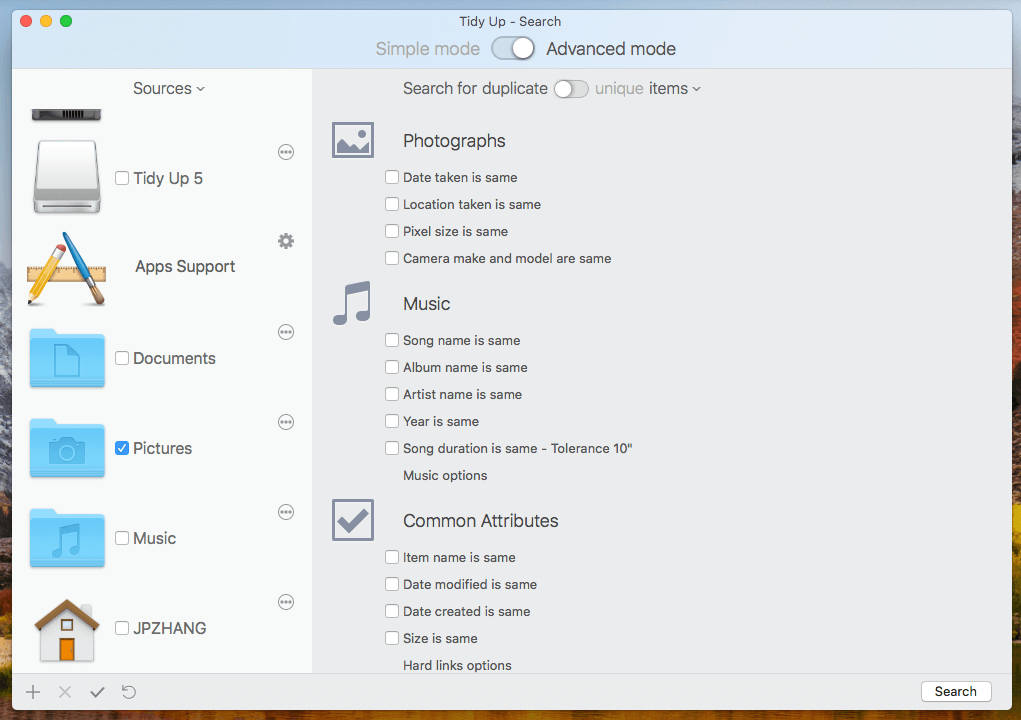
Scanning in process. Note that before the scan begins there was an option: it asks you to select between the “Slowest” and “Fastest” mode, which I assume represents surface scan and deep scan.
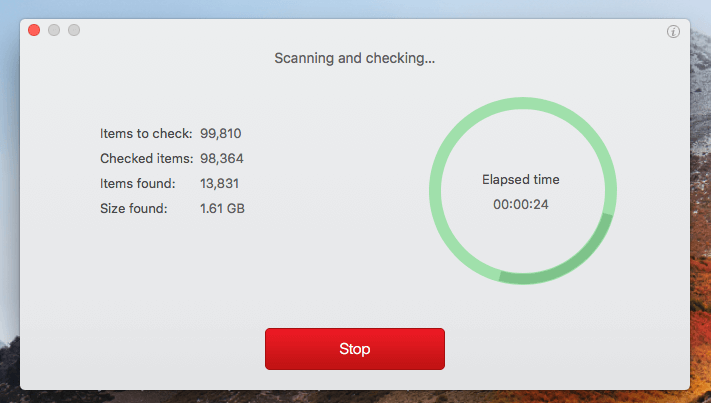
In a few minutes, Tiny Up was able to find 3.88 GB duplicates from my Documents folder. Like Gemini 2, it also automatically selects the duplicate items. All you have to do is review them carefully and hit the removal button in the corner.
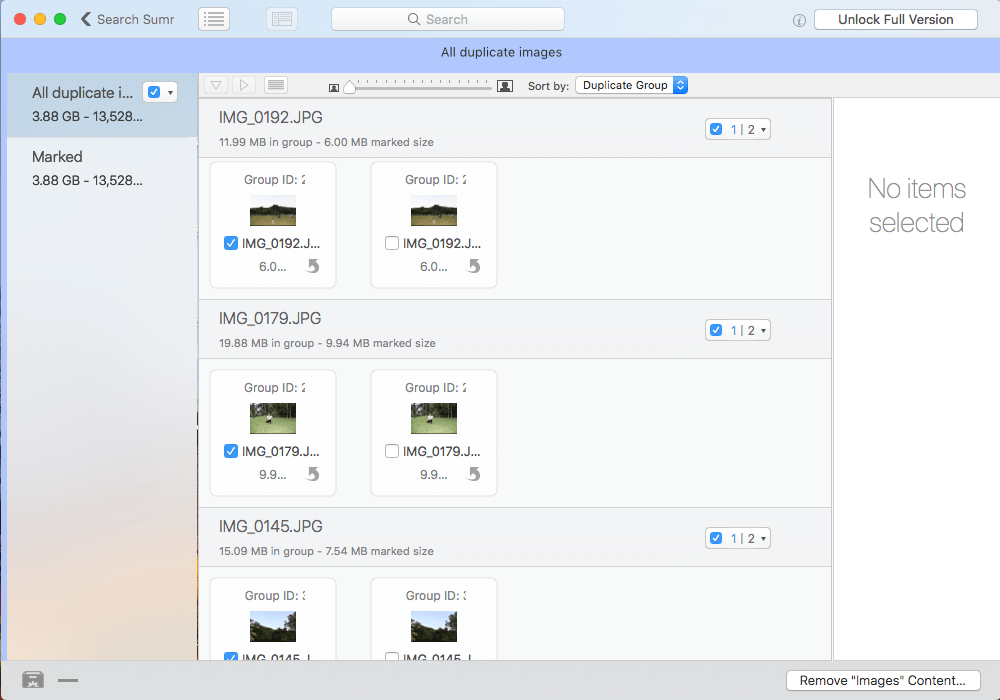
The trial version of Tidy Up allows you to delete no more than 10 items. That means if you want to fully remove those duplicates you’ll need to activate the app. I checked out their purchase page and learned the price starts from $28.99 USD per computer. If you’re already a user of Tidy Up 4, Hyperbolic Software offers a discount — $23.99 only to activate three computers.
Personally, I think the app is indeed very powerful, though it is slightly on the pricier side. But don’t forget that it’s designed for power users, so, it’s unfair to complain about the pricing.
3. Duplicate Sweeper (Windows, macOS)
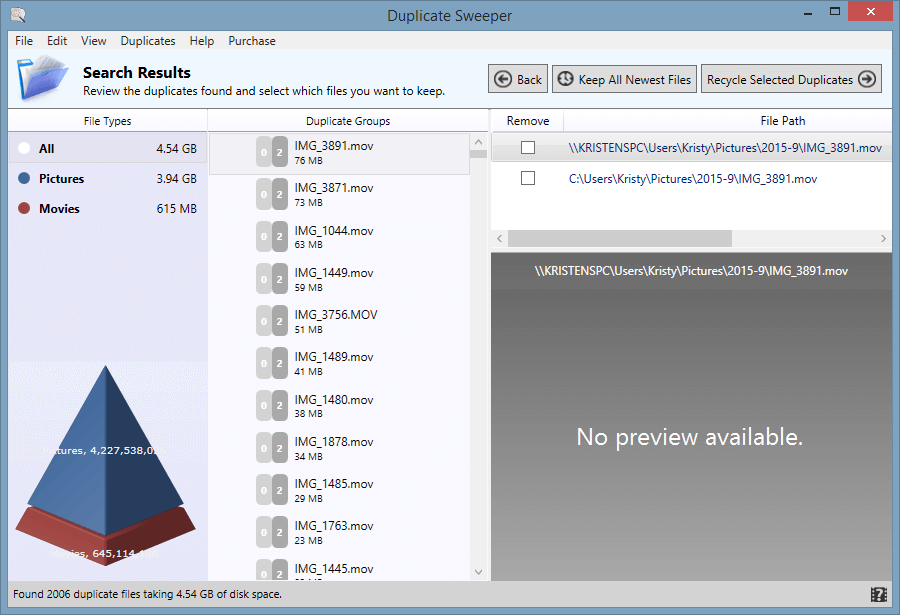
Zduplikowana zamiatarka bills itself as a utility to “make finding, selecting and removing duplicate files on your computer quick and easy.” I ran the program and performed a test scan of my desktop. Since my ASUS runs Windows 8.1, all my file folders are structured under the main heading “This PC.”
Duplicate Sweeper allowed me to narrow my search by selecting specific folders. I tried out this feature by choosing my Pictures folder and cringed, knowing it would be pretty bad (I’m a picture hoarder). The scan took a couple of minutes. YIKES — 3.94 GB of duplicate pictures. I really need to clean that up!
JP also tested the macOS version on his MacBook Pro. Below is the snapshot of the app. One thing that JP found — and he thought Duplicate Sweeper could improve on this — is the file selection process. By default, the app doesn’t auto-select duplicate items. We think this makes the review and selection process tedious.
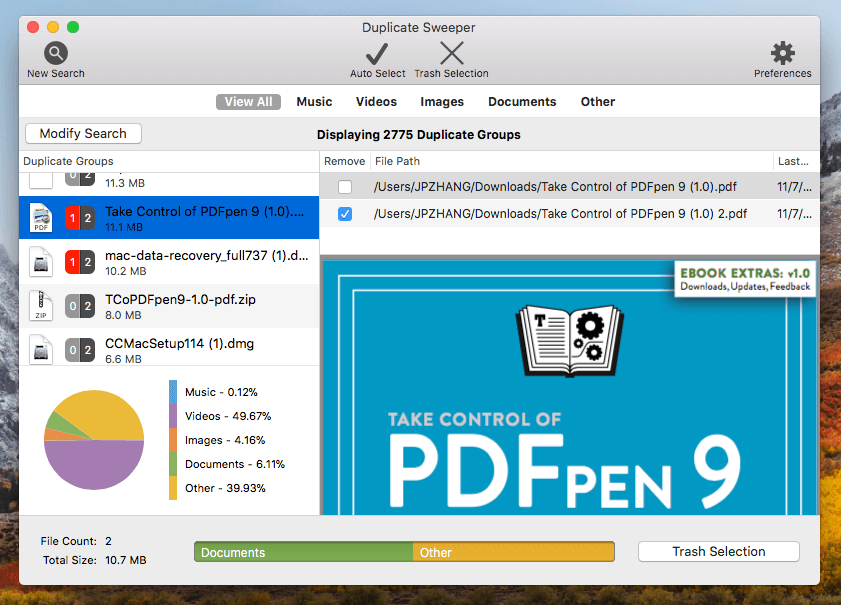
The trial version of Duplicate Sweeper only allows you to scan and verify what’s eating up your hard disk space and how much you’ll gain back, but you cannot remove any duplicate files. The full version costs $19.99 for an unlimited amount of deletions. You can also get the Mac version of Duplicate Sweeper on Mac App Store bo tylko 9.99 $.
4. Duplicate Detective (for Mac)
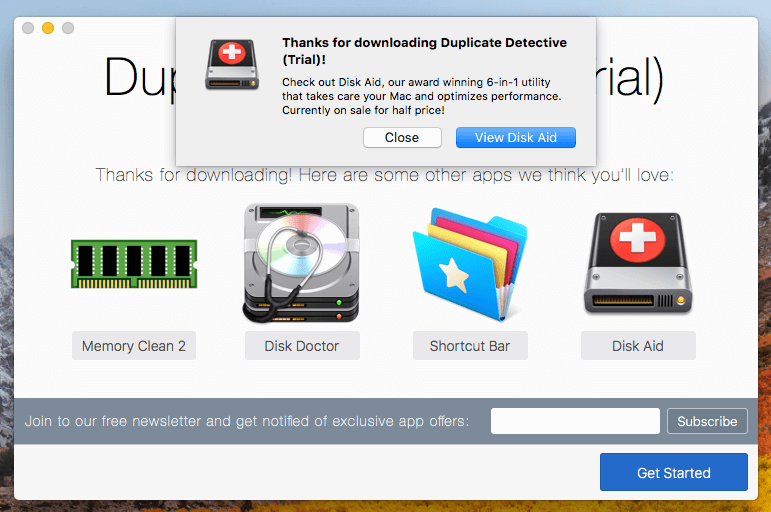
Duplicate Detective is another app worth considering for basic users. Like Gemini 2, it’s very simple to use. Just select a folder for a scan, review the found results, and remove duplicate items.
Priced at $4.99 (see on Mac App Store) only, Duplicate Detective is definitely one of the cheapest paid apps out there. That said, I think the app has some room to catch up in order to be featured in the winner’s spot. For example, I can’t specify which file types to scan; it doesn’t seem to be able to find similar files; the trial version has too many limitations (such as Auto Select feature disabled); you can’t remove files to test how it works.
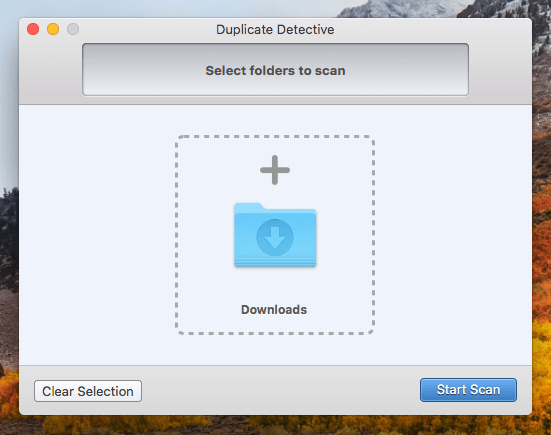
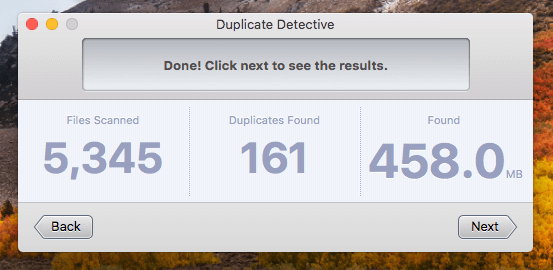
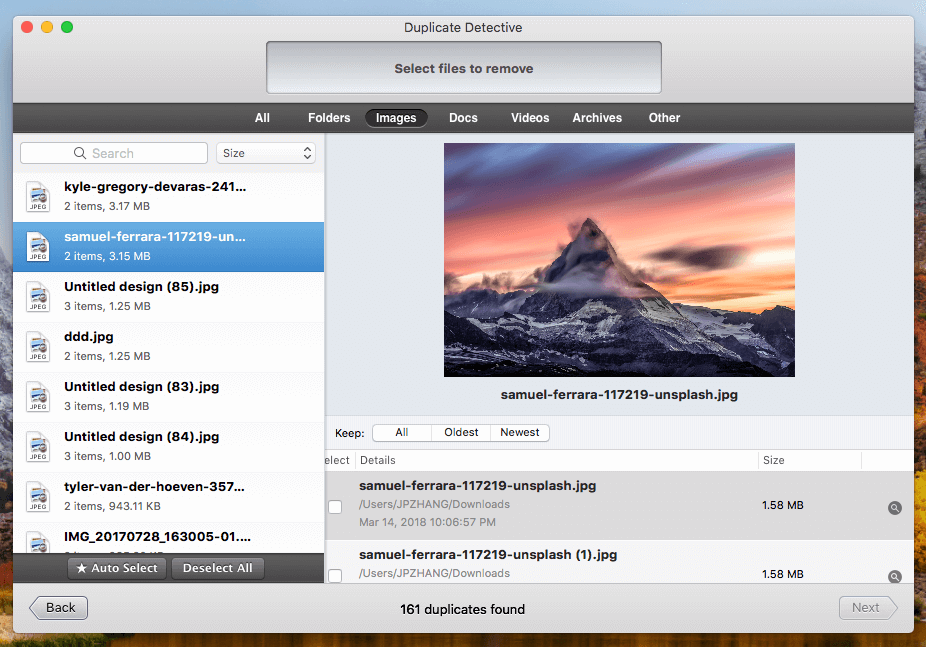
5. PhotoSweeper X (for Mac)
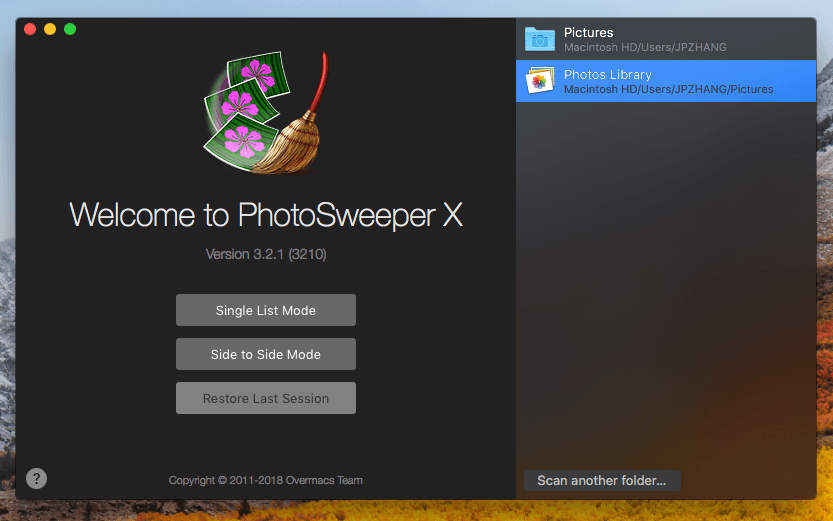
These days pictures and videos are probably the files that take up most of your storage. It’s good to see an app like PhotoSweeper that specifically focuses on users who only want to eliminate similar or duplicate photos. Overmacs (the team that developed the app) claims it’s able to find duplicate pictures from Mac’s folder and third-party photo apps like Photos, Aperture, Złap jednego, Lightroom.
Once you install the app and hopefully read the 6-page tutorial, you’ll come to this screen where you select which library to scan, and which mode to select: Single List Mode or Side to Side Mode. Confused about the difference between the two modes? I’m not going to elaborate here as you can click the question mark to learn more.
Next, drag and drop the folders into the main zone, and hit “Compare”. Within seconds, you’ll get to this screen with a number of options before it shows you those unnecessary duplicates.
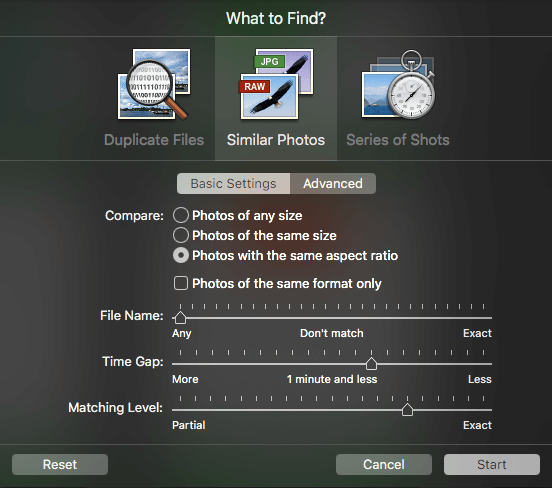
Here’s a quick screenshot of how each group of duplicate photos looks. Again, it’s highly recommended that you review each item before hitting the “Trash Marked” button.
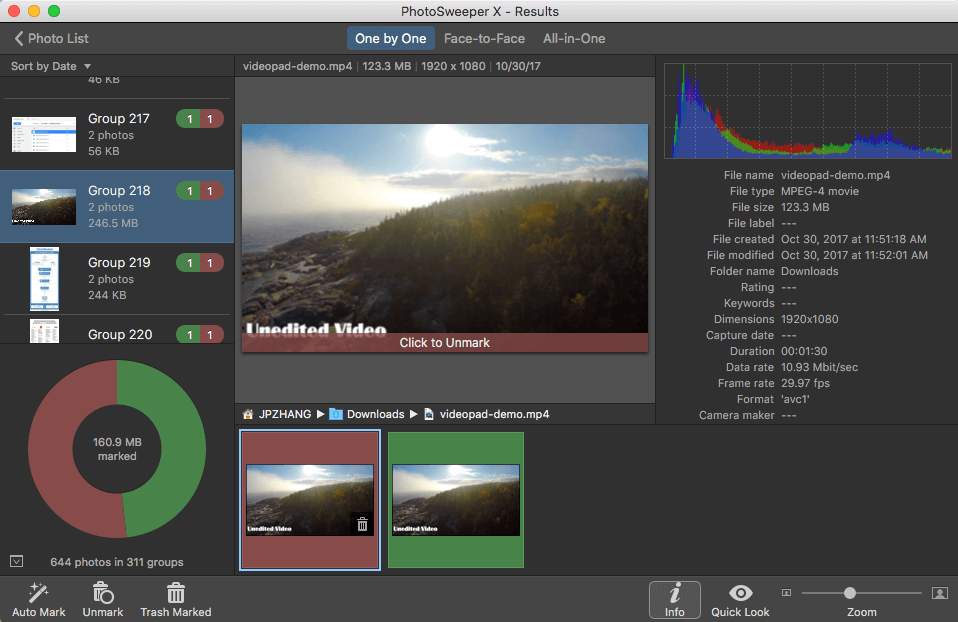
The trial version of PhotoSweeper X only allows you to remove up to 10 items. A full version is required to remove the limits and costs $10 USD.
One thing I dislike and feel it’s worth pointing out is their marketing tactic. I found it a bit annoying to see a ton of windows keep popping up. While I get it that the app isn’t free, I don’t want to be pushed to buy their app without giving it a try.
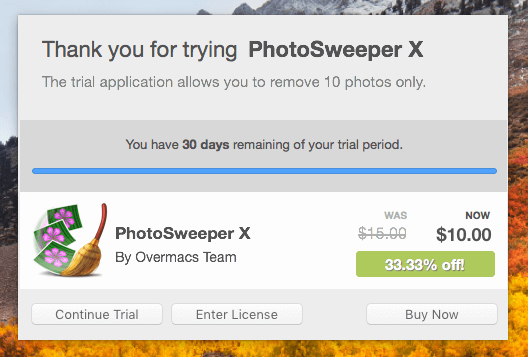

You can download the trial from PhotoSweeper’s official website tutaj, or get it from Mac App Store.
Some Free Duplicate File Finder Software
There are plenty of free duplicate file finders out there. We’ve tested quite a few. Some are comparable to the paid options we listed above. Again, some of them only support Windows or macOS, while others may be compatible with both.
1. dupeGuru (Windows, macOS, Linux)
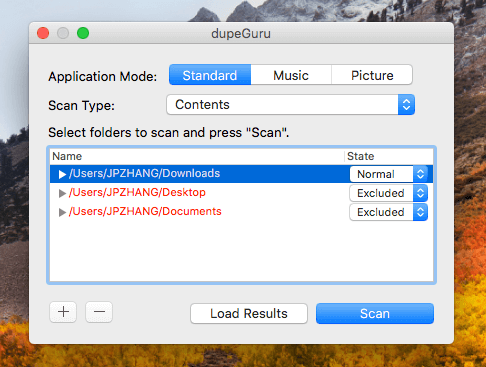
Originally developed by Virgil Dupras from Hardcoded Software, dupeGuru is now not maintained by Virgil anymore. After replacement Andrew Senetar took it on, I had more hope that this app isn’t going to disappear soon. Having been involved in the software industry for nearly a decade, I know how hard it is to maintain a freeware or open source program. Hats off to those great developers!
Back to the app itself. dupeGuru can scan your computer hard drive either by filenames or by contents. The developer claims that “the filename scan features a fuzzy matching algorithm that can find duplicate filenames even when they are not exactly the same.” I ran the app on my Mac and searched the Download folder.
Here’s what dupeGuru found in less than a minute — 316 duplicate items taking up 448 MB. It’s super efficient. One thing I dislike about the app is that it doesn’t select those redundant copies automatically, meaning you’ll have to select them one by one. Maybe the developer team wants us to review each item carefully. However, I think this can be really time-consuming.
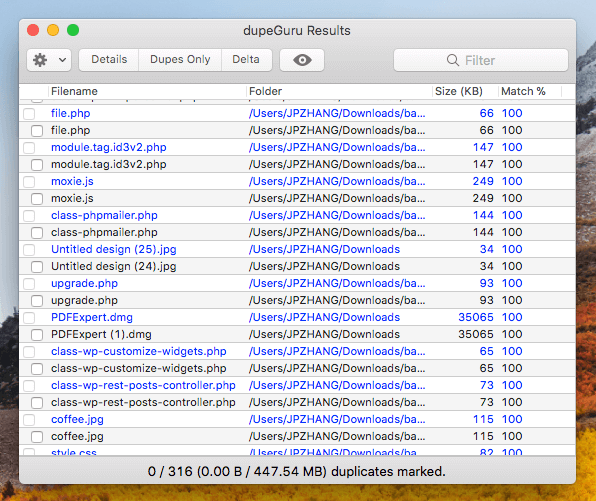
Plus, I found the app’s user interface lags compared to that of the winners we’ve chosen. However, it’s free so I can’t complain that much The app also supports a handful of languages including English, French, German, and others.
Kristen tried the Windows version on her ASUS PC (64-bit, Windows 8.1). Surprisingly, dupeGuru wouldn’t run at all. It says her PC was missing the latest version of Visual Basic C++, so a wizard popped up and tried downloading the required file(s) — a 4.02 MB download — which was interesting but annoying.
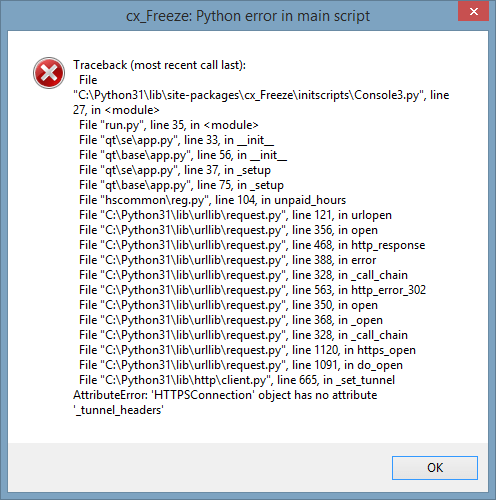
If the download can’t complete, you can opt to bypass it and finish getting the software without it. She tried finding a way to get the missing Visual Basic file, then bypassed — and before she even got to download the software program she got a traceback error. That’s a first. She wasn’t willing to wrestle with it any further. Too bad, because according to the official site DupeGuru is a powerful duplicate file finder; it can detect not only exact files but also similar ones. Named the Power Marker, it’s a feature you have to be careful with since DupeGuru may list a similar file as a duplicate needing to be deleted when in reality it’s not.
2. CCleaner (Windows, macOS)
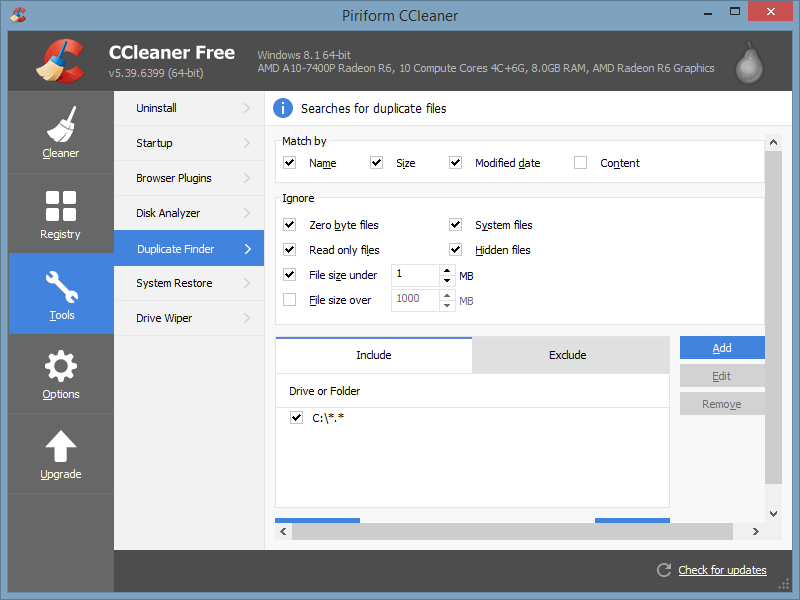
Technicznie, CCleaner is more than a duplicate finder. It is a utility program used to fix invalid Windows Registry entries and clean potentially unwanted files from your computer. Piriform, the developer, claims the program has been downloaded over 2 billion times. But the “malware crisis” in late 2017 almost destroy the brand. Learn more about that in ten artykuł we covered earlier.
The “Duplicate Finder” feature isn’t immediately displayed with CCleaner, as the app includes a handful of tools that do more than just get rid of excessive repeat files. You can find the feature under the Narzędzia menu. CCleaner allows you to search for duplicate files by file name, size, date, and even content. You can also ignore/include specific files and folders for scanning.
I ran my usual test scan on just my desktop. The CCleaner results showed that I had no duplicate files, yet a pop-up told me that CCleaner could save me over 770 MB of disk space. A follow-up scan to my C drive produced more accurate results. You can manually select the duplicates you want to remove with the option to save to a text file.
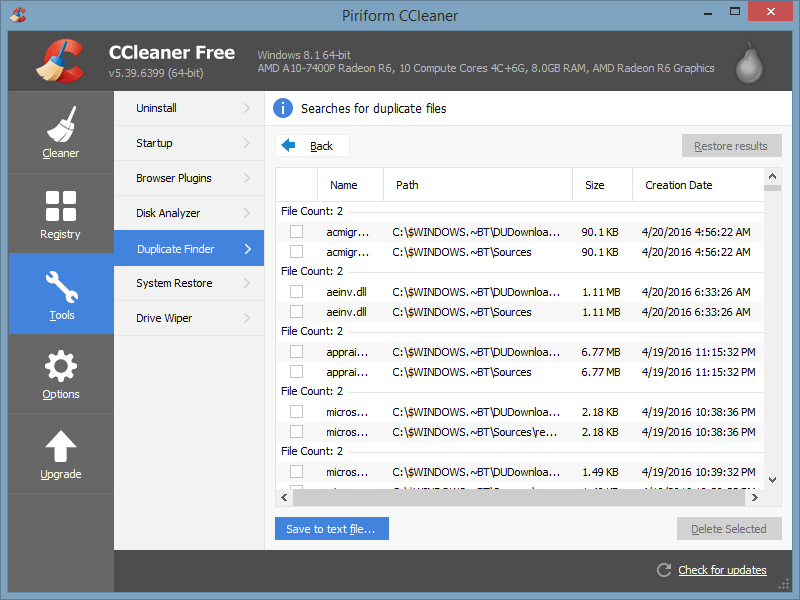
CCleaner offers a free evaluation version as well as two pro versions. The $24.95 option includes deeper, more extensive scanning; real-time junk file protection; and auto browser history clearing. In addition, when you pay the $69.95 (you might be able to get a better price when it’s on sale) you’ll get file recovery, computer upgrade protection, and a hard disk cleaner called Defraggler.
3. Glary Duplicate Cleaner (for Windows)
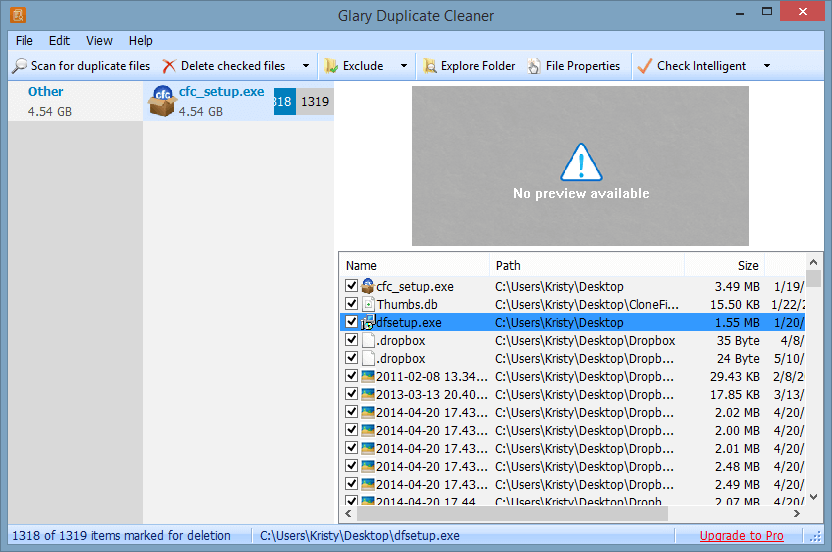
Glary Duplicate Cleaner is completely free and it claims to have the fastest scan program in the industry. Within only two clicks, it can deep scan for all types of files including photos, videos, Word documents, songs, etc.
On the first scan, without changing any settings, Glary couldn’t detect any of the 11 duplicates all the other file finder programs had. I had to change the options to scan “all files” and even then go back and deselect search by the same name, time, and file type.
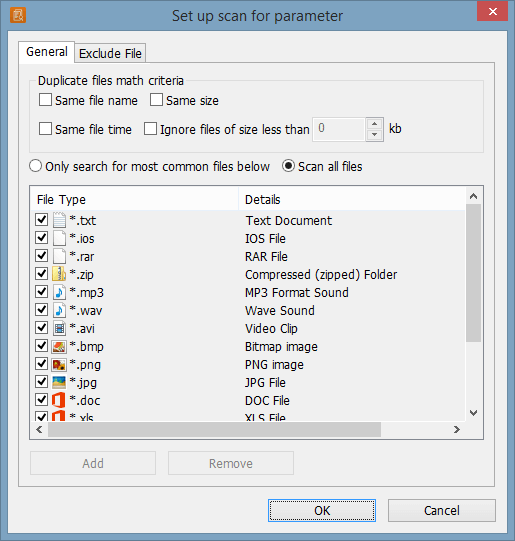
At that point, I could run a scan of my desktop (which took a while) that would produce some results — but not the same as most of the other competitors. This particular program requires some more advanced computer skills and knowledge to navigate. It’ll display results by file type and name, and you can view individual file properties right inside the Glary program.
4. SearchMyFiles (for Windows)
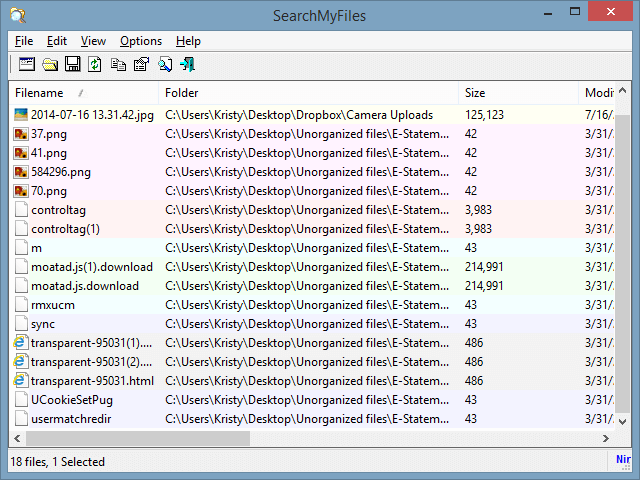
SearchMyFiles is not for the faint of heart. Upon first glance, the user interface is pretty intimidating. It has most of the same search options as the other duplicate file finders and starts up right away from download through an executable file.
After a test scan of my desktop, SearchMyFiles produced the same duplicate file results as the other competitors like Easy Duplicate Finder, just not in the pretty packaging. But the program works accurately, and it’s free. The results open up in a separate window with no scan progress indication, so you’ll need some patience if you’re scanning a big drive.
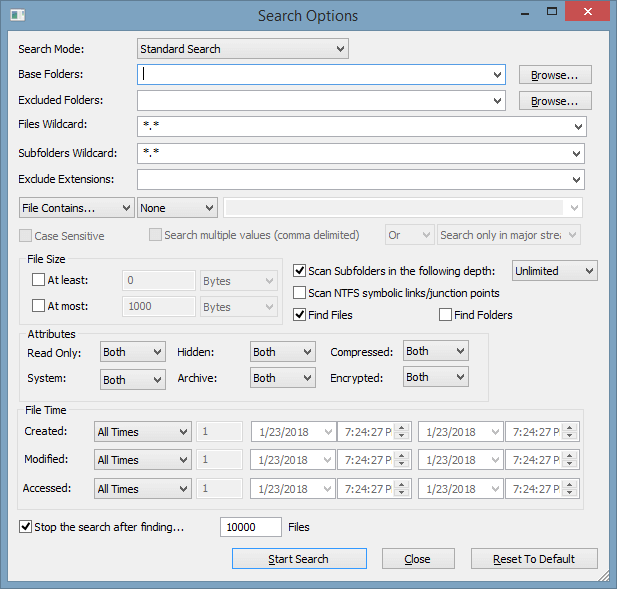
With SearchMyFiles, you can run standard as well as duplicate and non-duplicate searches on files by name, size, or time, and include and exclude folders and file extensions. This freeware app also offers advanced scan options that require strong computer skills to navigate. You can pobierz go za darmo tutaj.
5. CloneSpy (for Windows)
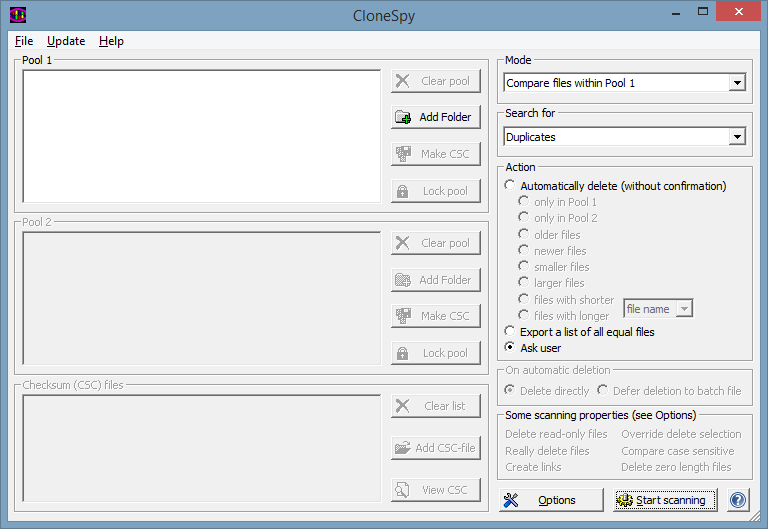
CloneSpy is another free duplicate file cleanup tool built for Windows (XP/Vista/7/8/8.1/10). The interface isn’t super easy to navigate, but it has a surprisingly wide range of search options. During a basic scan, it only found 6 duplicates of the 11 on my desktop and even less on a scan of my C drive.
According to the CloneSpy website, the software doesn’t find duplicate files in certain locations for security reasons, so it may not always dig as deep as your hard drive requires. Some scan restrictions do exist. With proper handling, I’m sure it can do some powerful search-and-deletes. The results window display is preventative for just deleting anything and everything; a safety feature to keep you from deleting something you shouldn’t.
You can visit the official website of CloneSpy and download the program here.
How We Tested and Picked These Duplicate Finders
These days it’s becoming harder to put different programs competing in the same space to test because they all seem to cater to specific audiences. Some are designed for computer newbies who aren’t tech-savvy, while others are for gurus (aka, power users) who are comfortable with computers. It’s challenging, yet unfair, to benchmark them with the same criteria. Nevertheless, here are the factors we took into consideration during our testing.
How deep will the program scan and how accurate is it to find duplicates?
A good duplicate file finder can do a more thorough search (also called deep search in some programs) and be as specific as possible in its approach to scanning your computer hard drive. Most of the time, you just need to make a few clicks following the software instructions before letting it scan. Those options may include, for instance, scanning by folder or drive, searching specific apps like Photos for Mac, including/excluding specific file types during a scan, setting the desired file type/size/time, etc.
How customized are the searching methods?
This varies by software. The more file extensions, names, times, and sizes an app can detect, the more duplicates it can dredge up. Also, this helps find specific types of duplicate files more efficiently. Imagine: You know you have tons of duplicate pictures stored in the Pictures folder. All you have to do with a duplicate finder is define the search method to include images, then scan only that folder.
Does it let you view your duplicates before deleting them?
What can you do with duplicate files once they’re detected? Good software will make it easy for you to compare originals and copies and safely deal with them. Most programs offer file preview ability so you know what you’re deleting before you do so. This is especially helpful for photos. Also, some duplicate file finders, like the winners we selected below, allow you to detect similar — not just exact files that you may not want to delete.
Can you undo what you just did?
Most duplicate file finders offer a restore option if you accidentally delete something you shouldn’t. Some software programs will let you export the duplicates instead of deleting them or save them to a specific temporary folder to deal with later. The point is that you should be able to reverse those delete operations.
Jak łatwy w użyciu?
Easy doesn’t necessarily mean thorough. Some duplicate file finders are not super user-friendly and take some know-how to navigate. You may not want to waste your time wrestling with a piece of software that takes forever to learn. I encountered one duplicate file finder that would’ve been wonderful to test out if I didn’t keep getting pop-up errors before I could even download it.
Is the program compatible with your computer OS?
If you are on a PC, you expect a piece of software run smoothly on the version of Windows you’ve installed, be it Windows 7, or Windows 11. Likewise, for Mac users, you want the app to be compatible with the macOS version your Mac machine is running.
Ostatnie słowa
We’ve also tested a number of other duplicate finder software out there but decided to not include them either because they are outdated (e.g. doesn’t support Windows 10 or the latest macOS), or we think they are way less superior compared to the best duplicate finder software we chose. However, we are open to hearing what you think.
If you happen to find a great app that’s worth being featured here, leave a comment and let us know.
Przeczytaj również
Derniers articles